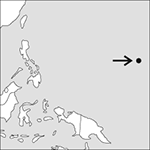
Source: MAPS IN MINUTES™ © RH Publications (1997)
Capital:
Majuro
Area:
181 sq km (70 sq miles)
Population:
69,747 (2013 est)
Currency:
1 US dollar=100 cents
Religions:
Protestant 54.8%; Assembly of God 25.8%; Roman Catholic 8.4%
Ethnic Groups:
Marshallese 92.1%; mixed Marshallese 5.9%
Languages:
Marshallese, English (both official)
International Organizations:
UN; Pacific Islands Forum; Secretariat of the Pacific Community
A country consisting of a cluster of 29 low-lying atolls and five islands in the central Pacific.
Physical
The archipelago comprises two parallel chains of islands, the Ratak (sunrise) chain to the east and the Ralik (sunset) chain to the west. The islands are coral caps over dome volcanoes and have a tropical climate.
Economy
Farming and fishing are the main economic activities, and coconut oil and copra are exported. The Marshall Islands depend on US aid and lease payments for the US military base on Kwajalein Atoll. It provides a ‘flag of convenience’ shipping registration service, and has the third largest registered merchant fleet in the world.
History
The islands were originally inhabited by Micronesians. They were sighted by European sailors in 1529 but were not exploited. The islands were named after a British captain who visited them in 1788. In 1886 the Marshall Islands became a German protectorate. After World War I the islands were administered by Japan, and after World War II they became a UN Trust Territory under US administration. From 1946 until 1958 the US used Bikini and other atolls in the group for atomic bomb tests. In 1986 they were given semi-independence in a ‘compact of free association’ in which the USA maintained control over military activities. The Trusteeship was terminated in 1990 and the country joined the United Nations the following year. In 1992 the US government made the first payments to islanders of compensation for personal injury resulting from the testing of nuclear weapons. In 2003 a new compact with the USA was signed, providing US financial support up to 2024.
- extrusion reaction
- extrusive
- exurb
- eye
- eye candy
- eye lens
- eyelet-construction mica capacitor
- eye muscle
- eyepiece
- eye relief
- eyespot
- eye tooth
- eye tracking
- Eyharts, Léopold (1957– )
- eyot
- Eyring equation
- Eyring, Henry
- Eyring, Henry (1901–81)
- ezine
- Eötvös, Baron Lóránd von
- Eötvös effect
- E–isomer
- E–Z convention
- F
- f